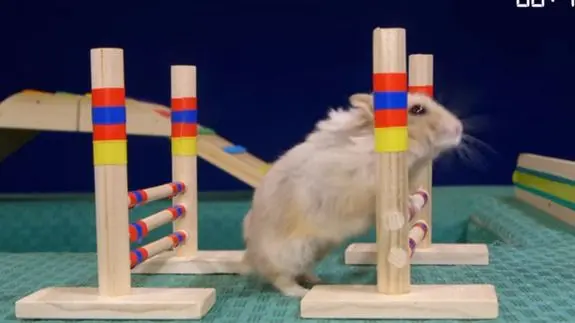Clicker training is a powerful and effective method to train animals, including hamsters, using positive reinforcement. This technique can help you teach your hamster various tricks, improve their behavior, and strengthen the bond between you and your pet. In this guide, we’ll explore the principles of clicker training, the benefits it offers, and step-by-step instructions on how to clicker train your hamster.
Introduction to Clicker Training
Clicker training is a form of operant conditioning, a learning process where an animal learns to associate a specific behavior with a reward. The clicker is a small, handheld device that produces a distinct “click” sound when pressed. This sound serves as a “bridge” or “marker” that tells the animal precisely when they have performed the desired behavior and that a reward is coming.
Benefits of Clicker Training for Hamsters
Clicker training offers several benefits for both you and your hamster:
1. Positive reinforcement:
Clicker training relies on rewarding good behavior rather than punishing undesirable actions. This approach fosters a positive relationship between you and your hamster, making training sessions enjoyable for both parties.
2. Clear communication
The clicker’s distinct sound helps your hamster understand exactly what behavior is being rewarded, reducing confusion and frustration during training.
3. Mental stimulation
Clicker training sessions provide your hamster with mental challenges and help prevent boredom, which in turn prevents behavior issues such as chewing on just about anything it finds, unnecessary aggression,.nd more. Clicker training is a popular way to socialize and exercise guinea pigs, rats, and other small animals.
4. Bonding
Clicker training sessions strengthens the bond between you and your hamster, building trust and understanding.
What You Need To Begin
Before you begin clicker training your hamster, you will need the following items:
The Clicker
Obviously the first thing you need. A clicker is a small, handheld device that produces a distinct “click” sound when pressed. You can find really good clickers on Amazon.
Treats
Small, easily consumed treats that your hamster loves. These should be healthy and used exclusively for training purposes. Examples include small pieces of fruit, vegetables, or commercial hamster treats.
Training area
A quiet, distraction-free space where you can conduct your training sessions.
Step-by-Step Guide to Clicker Training Your Hamster

Step 1: Introducing the Clicker
The first step in clicker training is to help your hamster associate the clicker’s sound with receiving a treat. This process is known as “charging the clicker.”
- Prepare a handful of your hamster’s favorite treats.
- In a quiet, distraction-free environment, press the clicker and immediately give your hamster a treat.
- Repeat this process several times, with a short pause between each click-treat pairing.
- Continue this exercise for a few days until your hamster shows signs of anticipation or excitement when they hear the clicker.
Step 2: Teaching Basic Commands
Once your hamster has learned to associate the clicker with a reward, you can begin teaching them basic commands and tricks. Start with simple behaviors that your hamster naturally performs, such as climbing or standing on their hind legs.
- Choose a command or trick you would like to teach your hamster (e.g., “climb” or “stand”).
- Wait for your hamster to perform the desired behavior on their own.
- As soon as your hamster performs the behavior, click the clicker and provide a treat.
- Repeat this process until your hamster consistently performs the behavior in response to the clicker. This may take several training sessions.
Step 3: Adding a Cue
Once your hamster has mastered a particular behavior, you can introduce a verbal or visual cue to signal when you want them to perform the action.
- Choose a simple, consistent cue for the command (e.g., “climb” or “stand”).
- Give the cue just before your hamster performs the behavior.
- When your hamster performs the desired behavior, click the clicker and provide a treat.
- Practice this process until your hamster consistently responds to the cue by performing the behavior.
Step 4: Expanding Your Hamster’s Repertoire
After your hamster has mastered one command or trick, you can begin teaching them new behaviors following the same process. Gradually increase the complexity of the commands and tricks, making sure that your hamster is comfortable and confident with each new skill.
Tips for Successful Clicker Training
- Keep sessions short: Hamsters have short attention spans, so limit training sessions to 5-10 minutes to prevent frustration and boredom.
- Be patient: Learning new behaviors takes time and practice. Be patient with your hamster and avoid rushing the process.
- Be consistent: Use the same cues and reward system for each behavior to avoid confusing your hamster.
- End on a positive note: Finish each training session with a successful behavior and reward to leave your hamster feeling confident and motivated.
Conclusion
Clicker training is a fun and effective way to teach your hamster new tricks, improve their behavior, and strengthen your bond. With patience, consistency, and positive reinforcement, you and your hamster can enjoy the benefits of clicker training and embark on a rewarding journey of learning and bonding together.
![Clicker Training Your Hamster [The Ultimate Guide]](https://animajestic.com/wp-content/uploads/CLICKER-TRAINING-HAMSTER.webp)